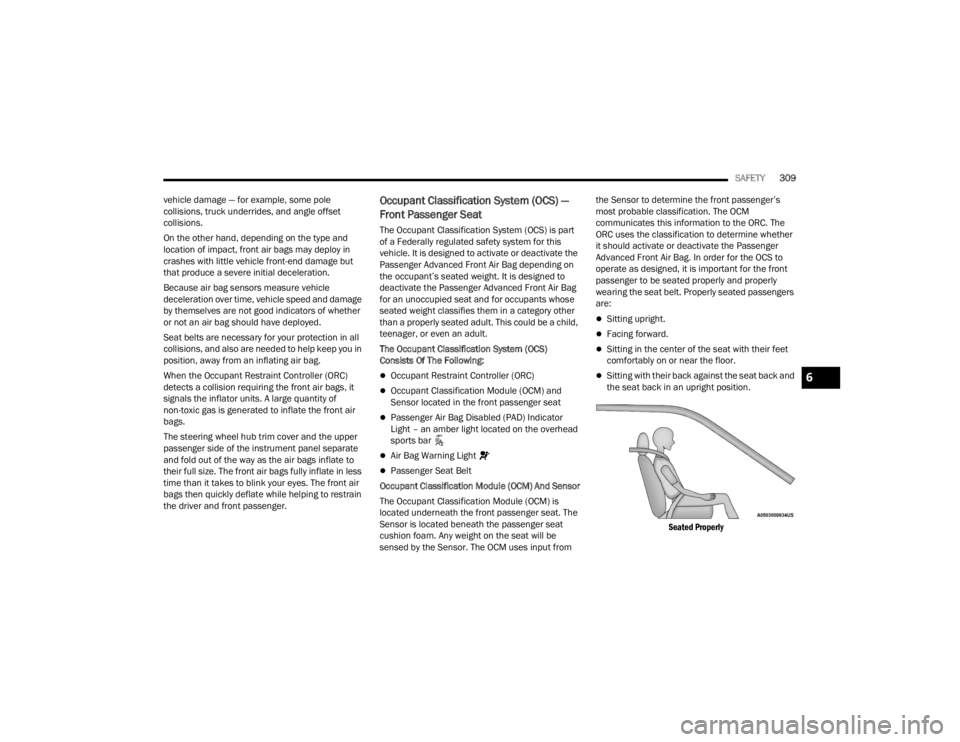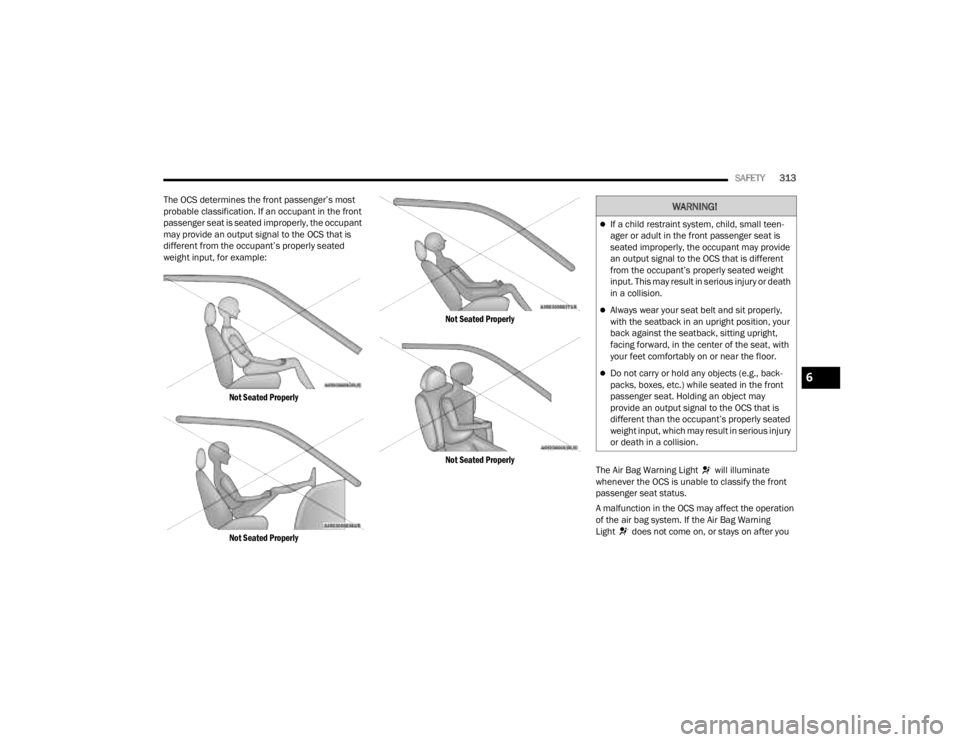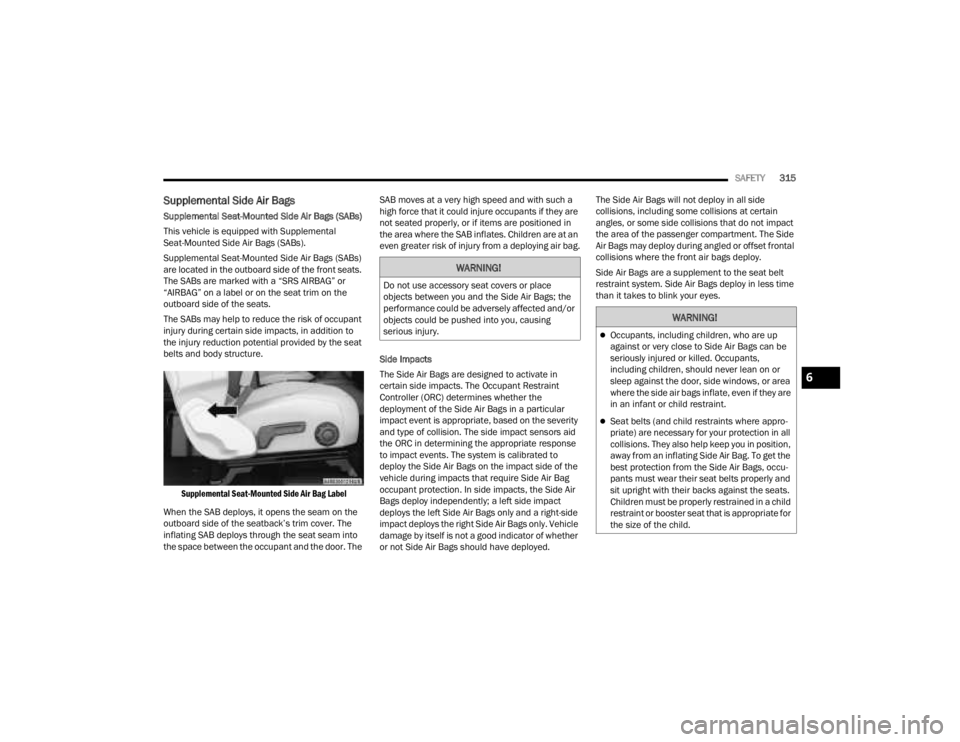JEEP GLADIATOR 2023 Owners Manual
Manufacturer: JEEP, Model Year: 2023, Model line: GLADIATOR, Model: JEEP GLADIATOR 2023Pages: 448, PDF Size: 17.37 MB
Page 311 of 448

SAFETY309
vehicle damage — for example, some pole
collisions, truck underrides, and angle offset
collisions.
On the other hand, depending on the type and
location of impact, front air bags may deploy in
crashes with little vehicle front-end damage but
that produce a severe initial deceleration.
Because air bag sensors measure vehicle
deceleration over time, vehicle speed and damage
by themselves are not good indicators of whether
or not an air bag should have deployed.
Seat belts are necessary for your protection in all
collisions, and also are needed to help keep you in
position, away from an inflating air bag.
When the Occupant Restraint Controller (ORC)
detects a collision requiring the front air bags, it
signals the inflator units. A large quantity of
non-toxic gas is generated to inflate the front air
bags.
The steering wheel hub trim cover and the upper
passenger side of the instrument panel separate
and fold out of the way as the air bags inflate to
their full size. The front air bags fully inflate in less
time than it takes to blink your eyes. The front air
bags then quickly deflate while helping to restrain
the driver and front passenger.
Occupant Classification System (OCS) —
Front Passenger Seat
The Occupant Classification System (OCS) is part
of a Federally regulated safety system for this
vehicle. It is designed to activate or deactivate the
Passenger Advanced Front Air Bag depending on
the occupant’s seated weight. It is designed to
deactivate the Passenger Advanced Front Air Bag
for an unoccupied seat and for occupants whose
seated weight classifies them in a category other
than a properly seated adult. This could be a child,
teenager, or even an adult.
The Occupant Classification System (OCS)
Consists Of The Following:
Occupant Restraint Controller (ORC)
Occupant Classification Module (OCM) and
Sensor located in the front passenger seat
Passenger Air Bag Disabled (PAD) Indicator
Light – an amber light located on the overhead
sports bar
Air Bag Warning Light
Passenger Seat Belt
Occupant Classification Module (OCM) And Sensor
The Occupant Classification Module (OCM) is
located underneath the front passenger seat. The
Sensor is located beneath the passenger seat
cushion foam. Any weight on the seat will be
sensed by the Sensor. The OCM uses input from the Sensor to determine the front passenger’s
most probable classification. The OCM
communicates this information to the ORC. The
ORC uses the classification to determine whether
it should activate or deactivate the Passenger
Advanced Front Air Bag. In order for the OCS to
operate as designed, it is important for the front
passenger to be seated properly and properly
wearing the seat belt. Properly seated passengers
are:
Sitting upright.
Facing forward.
Sitting in the center of the seat with their feet
comfortably on or near the floor.
Sitting with their back against the seat back and
the seat back in an upright position.
Seated Properly
6
23_JT_OM_EN_USC_t.book Page 309
Page 312 of 448

310SAFETY
The OCS may deactivate the deployment of the Passenger Advanced Front Air Bag if the OCS estimates that:
The front passenger seat is unoccupied or has very light objects in it.
The front passenger seat is occupied by a rear-facing child restraint.
The front passenger seat is occupied by a child, including a child seated in a forward-facing child restraint or booster seat.
The front passenger seat is occupied by a small passenger, including a child or small adult.
The front passenger is not properly seated or his or her weight is taken off of the seat for a period of time.
* When the front passenger seat is empty or when very light objects are placed on the seat and the seat belt is unbuckled, the Passenger Advanced Front Air Bag will not deploy even
though the PAD System Indicator Light is NOT illuminated.
** It is possible for a child to be classified as an adult, allowing the deployment of the Passenger Advanced Front Air Bag. Never allow children to ride in the front passenger seat and
never install a child restraint system, including a rear-facing child restraint, in the front passenger seat.
Passenger Air Bag Disable (PAD) System
Front Passenger Seat Occupant Status Front Passenger Advanced Air Bag Disabled
Indicator Light (“PAD”) Status Front Passenger Air Bag Status
Unoccupied seat* Unbuckled NOT ILLUMINATEDDEACTIVATED
Unoccupied seat* Buckled “PASSENGER AIR BAG OFF” DEACTIVATED
Grocery bags, heavy briefcases, and other relatively light objects “PASSENGER AIR BAG OFF”
DEACTIVATED
Rear-facing child restraint** “PASSENGER AIR BAG OFF” DEACTIVATED
Child, including a child in a forward-facing child restraint or booster seat** “PASSENGER AIR BAG OFF”
DEACTIVATED
Small adult “PASSENGER AIR BAG OFF” DEACTIVATED
Properly seated adult NOT ILLUMINATED ACTIVATED
23_JT_OM_EN_USC_t.book Page 310
Page 313 of 448

SAFETY311
Passenger Advanced Front Air Bag Disabled (PAD)
Indicator Light
The Passenger Advanced Front Air Bag Disabled
(PAD) Indicator Light (an amber light located on the
overhead sports bar) tells the driver and front
passenger when the Passenger Advanced Front Air
Bag is deactivated. The PAD Indicator light
illuminates the words “PASSENGER AIR BAG OFF”
to show that the Passenger Advanced Front Air Bag
will not deploy during a collision. When the front
passenger seat is empty or when very light objects
are placed on the seat and the seat belt is
unbuckled, the Passenger Advanced Front Air Bag
will not deploy even though the PAD indicator light
is NOT illuminated. The PAD indicator light should not be illuminated
when an adult passenger is properly seated in the
front passenger seat. The driver and adult
passenger should verify that the PAD Indicator
Light is not illuminated when an adult is riding in
the front passenger seat. If an adult is not seated
properly, the Passenger Advanced Front Air Bag
may deactivate and the PAD Indicator Light will be
illuminated.
The PAD Indicator Light should be illuminated and
the Passenger Advanced Front Air Bag should be
deactivated for most properly seated and
restrained children in the passenger seat and for
most properly installed child restraint systems.
However, under certain conditions, even with a
properly installed child restraint system, the PAD
Indicator Light may not be illuminated, even
though the Passenger Advanced Front Air Bag is
deactivated. This can occur if the child restraint is
lighter than the lightest weight necessary to
illuminate the PAD Indicator Light.
NEVER assume
the Passenger Advanced Front Air Bag is
deactivated unless the PAD Indicator Light is
illuminated with the words “PASSENGER AIR BAG
OFF.”
NOTE:If the seat belt is buckled for an empty seat, the
PAD Indicator Light will illuminate. If The PAD Indicator Light Is Illuminated For An
Adult Passenger:
If an adult passenger is seated in the front
passenger seat and the PAD Indicator Light is
illuminated, the passenger may be sitting
improperly. Follow the steps below to allow the
OCS to detect the adult passenger’s seated weight
to activate the Passenger Advanced Front Air Bag:
1. Turn off the vehicle and have the adult
passenger step out of the vehicle.
2. Remove any extra materials from the passenger seat, such as cushions, pads, seat
covers, seat massagers, blankets, extra
clothing, etc.
3. Place the seatback in the full upright position.
4. Have the adult passenger sit in the center of the seat, with the passenger’s feet
comfortably on or near the floor, and with their
back against the seatback.
5. Restart the vehicle and have the passenger remain in this seated position for two to three
minutes after restarting the vehicle.
WARNING!
Never place a rear-facing child restraint in
front of an air bag. A deploying passenger
front air bag can cause death or serious injury
to a child 12 years or younger, including a
child in a rear-facing child restraint.
Never install a rear-facing child restraint in the
front seat of a vehicle. Only use a rear-facing
child restraint in the rear seat. If the vehicle
does not have a rear seat, do not transport a
rear-facing child restraint in that vehicle.
6
23_JT_OM_EN_USC_t.book Page 311
Page 314 of 448

312SAFETY
Lighter Weight Passengers (Including Small Adults)
When a lighter weight passenger, including a small
adult, occupies the passenger seat, the Passenger
Advanced Front Air Bag may be deactivated.
Therefore, the Passenger Advanced Front Air Bag may or may not be activated for a lighter weight
passenger, including a small adult (depending on
size) who is seated in the passenger seat. This
does not mean that the OCS is working improperly.
The driver and passenger must always use the PAD
Indicator Light as a determination of whether the
Passenger Advanced Front Air Bag is activated or
deactivated. If the PAD Indicator Light is
illuminated with the words “PASSENGER AIR BAG
OFF” when an adult is in the front passenger seat,
have the passenger reposition his or her body in
the seat until the PAD Indicator Light goes out.
If the PAD Indicator Light is illuminated with the
words “PASSENGER AIR BAG OFF” the Passenger
Advanced Front Air Bag will not inflate in the event
of a collision.
Do Not Decrease OR Increase The Front
Passenger’s Seated Weight On The Front
Passenger Seat
The front passenger’s seated weight must be
properly positioned on the front passenger seat.
Failure to do so may result in serious injury or
death. The OCS determines the most probable
classification of the occupant that it detects. The
OCS will detect the front passenger’s decreased or
increased seated weight, which may result in
deactivation or activation of the Passenger
Advanced Front Air Bag in a collision. This does not
mean that the OCS is working improperly.
Decreasing the front passenger’s seated weight on the front passenger seat may result in deactivation
of the Passenger Advanced Front Air Bag causing
serious injury or death. Increasing the front
passenger’s seated weight on the front passenger
seat may result in activation of the Passenger
Advanced Front Air Bag. Examples of improper
front passenger seating include:
The front passenger’s weight is transferred to
another part of the vehicle (like the door, arm
rest or instrument panel).
The front passenger leans forward, sideways, or
turns to face the rear of the vehicle.
The front passenger’s seatback is not in the full
upright position.
The front passenger carries or holds an object
while seated (e.g., backpack, box, etc.).
Objects are lodged under the front passenger
seat.
Objects are lodged between the front passenger
seat and center console.
Accessories that may change the seated weight
on the front passenger seat are attached to the
front passenger seat.
Anything that may decrease or increase the
front passenger’s seated weight.
WARNING!
If the PAD Indicator Light remains illuminated
for an adult passenger, have an authorized
dealer service the air bag system immediately.
Failure to do so may cause serious injury or
death. If the PAD Indicator Light is illuminated
with the words "PASSENGER AIR BAG OFF,"
the Passenger Advanced Front Air Bag will not
deploy in the event of a collision.
Never place a rear-facing child restraint in
front of an air bag. A deploying passenger
front air bag can cause death or serious injury
to a child 12 years or younger, including a
child in a rear-facing child restraint.
Never install a rear-facing child restraint in the
front seat of a vehicle. Only use a rear-facing
child restraint in the rear seat. If the vehicle
does not have a rear seat, do not transport a
rear-facing child restraint in that vehicle.
Children 12 years or younger should always
ride buckled up in the rear seat of a vehicle
with a rear seat.
23_JT_OM_EN_USC_t.book Page 312
Page 315 of 448

SAFETY313
The OCS determines the front passenger’s most
probable classification. If an occupant in the front
passenger seat is seated improperly, the occupant
may provide an output signal to the OCS that is
different from the occupant’s properly seated
weight input, for example:
Not Seated Properly
Not Seated Properly Not Seated Properly
Not Seated Properly
The Air Bag Warning Light will illuminate
whenever the OCS is unable to classify the front
passenger seat status.
A malfunction in the OCS may affect the operation
of the air bag system. If the Air Bag Warning
Light does not come on, or stays on after you
WARNING!
If a child restraint system, child, small teen -
ager or adult in the front passenger seat is
seated improperly, the occupant may provide
an output signal to the OCS that is different
from the occupant’s properly seated weight
input. This may result in serious injury or death
in a collision.
Always wear your seat belt and sit properly,
with the seatback in an upright position, your
back against the seatback, sitting upright,
facing forward, in the center of the seat, with
your feet comfortably on or near the floor.
Do not carry or hold any objects (e.g., back -
packs, boxes, etc.) while seated in the front
passenger seat. Holding an object may
provide an output signal to the OCS that is
different than the occupant’s properly seated
weight input, which may result in serious injury
or death in a collision.6
23_JT_OM_EN_USC_t.book Page 313
Page 316 of 448

314SAFETY
start the vehicle, or it comes on as you drive, take
the vehicle to an authorized dealer for service
immediately. The passenger seat assembly contains critical OCS
components that may affect Passenger Advanced
Front Air Bag inflation. In order for the OCS to
properly classify the seated weight of a front seat
passenger, the OCS components must function as
designed. Do not make any modifications to the
front passenger seat components, assembly, or to
the seat cover. If the seat, trim cover, or cushion
needs service for any reason, take the vehicle to
an authorized dealer. Only FCA US LLC approved
seat accessories may be used.
The following requirements must be strictly
followed:
Do not modify the front passenger seat
assembly or components in any way.
Do not use prior or future model year seat
covers or cushions not designated by FCA US
LLC for the specific model being repaired.
Always use the correct seat cover and cushion
specified for the vehicle.
Do not replace the seat cover or cushion with an
aftermarket seat cover or cushion.
Do not add a secondary seat cover or mat.
At no time should any Supplemental Restraint
System (SRS) component or SRS related
component or fastener be modified or replaced
with any part except those which are approved
by FCA US LLC.
Knee Impact Bolsters
The Knee Impact Bolsters help protect the knees
of the driver and front passenger, and position the
front occupants for improved interaction with the
front air bags.
WARNING!
Ignoring the Air Bag Warning Light in your
instrument panel could mean you won’t have
the air bags to protect you in a collision. If the
light does not come on as a bulb check when
the ignition is first turned on, stays on after
you start the vehicle, or if it comes on as you
drive, have an authorized dealer service the
air bag system immediately.
Placing an object on the floor under the front
passenger seat may prevent the OCS from
working properly, which may result in serious
injury or death in a collision. Do not place any
objects on the floor under the front passenger
seat.
If there is a fault present in the OCS, both the
PAD Indicator Light and the Air Bag Warning
Light will illuminate to show that the
Passenger Advanced Front Air Bag is deacti
-
vated. Should this occur, the Passenger
Advanced Front Air Bag will remain deacti-
vated until the fault is cleared. This indicates
that you should take the vehicle to an autho -
rized dealer for service immediately.
WARNING!
Unapproved modifications or service proce-
dures to the passenger seat assembly, its
related components, seat cover, or cushion
may inadvertently change the air bag deploy -
ment in case of a frontal collision. This could
result in death or serious injury to the front
passenger if the vehicle is involved in a colli -
sion. A modified vehicle may not comply with
required Federal Motor Vehicle Safety Stan -
dards (FMVSS) and/or Canadian Motor
Vehicle Safety Standards (CMVSS).
If it is necessary to modify the air bag system
for persons with disabilities, contact an autho -
rized dealer.
WARNING!
Do not drill, cut, or tamper with the knee
impact bolsters in any way.
Do not mount any accessories to the knee
impact bolsters such as alarm lights, stereos,
citizen band radios, etc.
23_JT_OM_EN_USC_t.book Page 314
Page 317 of 448

SAFETY315
Supplemental Side Air Bags
Supplemental Seat-Mounted Side Air Bags (SABs)
This vehicle is equipped with Supplemental
Seat-Mounted Side Air Bags (SABs).
Supplemental Seat-Mounted Side Air Bags (SABs)
are located in the outboard side of the front seats.
The SABs are marked with a “SRS AIRBAG” or
“AIRBAG” on a label or on the seat trim on the
outboard side of the seats.
The SABs may help to reduce the risk of occupant
injury during certain side impacts, in addition to
the injury reduction potential provided by the seat
belts and body structure.
Supplemental Seat-Mounted Side Air Bag Label
When the SAB deploys, it opens the seam on the
outboard side of the seatback’s trim cover. The
inflating SAB deploys through the seat seam into
the space between the occupant and the door. The SAB moves at a very high speed and with such a
high force that it could injure occupants if they are
not seated properly, or if items are positioned in
the area where the SAB inflates. Children are at an
even greater risk of injury from a deploying air bag.
Side Impacts
The Side Air Bags are designed to activate in
certain side impacts. The Occupant Restraint
Controller (ORC) determines whether the
deployment of the Side Air Bags in a particular
impact event is appropriate, based on the severity
and type of collision. The side impact sensors aid
the ORC in determining the appropriate response
to impact events. The system is calibrated to
deploy the Side Air Bags on the impact side of the
vehicle during impacts that require Side Air Bag
occupant protection. In side impacts, the Side Air
Bags deploy independently; a left side impact
deploys the left Side Air Bags only and a right-side
impact deploys the right Side Air Bags only. Vehicle
damage by itself is not a good indicator of whether
or not Side Air Bags should have deployed.The Side Air Bags will not deploy in all side
collisions, including some collisions at certain
angles, or some side collisions that do not impact
the area of the passenger compartment. The Side
Air Bags may deploy during angled or offset frontal
collisions where the front air bags deploy.
Side Air Bags are a supplement to the seat belt
restraint system. Side Air Bags deploy in less time
than it takes to blink your eyes.
WARNING!
Do not use accessory seat covers or place
objects between you and the Side Air Bags; the
performance could be adversely affected and/or
objects could be pushed into you, causing
serious injury.
WARNING!
Occupants, including children, who are up
against or very close to Side Air Bags can be
seriously injured or killed. Occupants,
including children, should never lean on or
sleep against the door, side windows, or area
where the side air bags inflate, even if they are
in an infant or child restraint.
Seat belts (and child restraints where appro
-
priate) are necessary for your protection in all
collisions. They also help keep you in position,
away from an inflating Side Air Bag. To get the
best protection from the Side Air Bags, occu -
pants must wear their seat belts properly and
sit upright with their backs against the seats.
Children must be properly restrained in a child
restraint or booster seat that is appropriate for
the size of the child.
6
23_JT_OM_EN_USC_t.book Page 315
Page 318 of 448

316SAFETY
NOTE:Air bag covers may not be obvious in the interior
trim, but they will open during air bag deployment.
Air Bag System Components
NOTE:The Occupant Restraint Controller (ORC) monitors
the internal circuits and interconnecting wiring
associated with electrical Air Bag System Compo -
nents listed below:
Occupant Restraint Controller (ORC)
Air Bag Warning Light
Steering Wheel and Column
Instrument Panel
Knee Impact Bolsters
Driver and Front Passenger Air Bags
Seat Belt Buckle Switch
Supplemental Side Air Bags
Front and Side Impact Sensors
Seat Belt Pretensioners
Seat Track Position Sensors
Occupant Classification System
If A Deployment Occurs
The front air bags are designed to deflate
immediately after deployment.
NOTE:Front and/or side air bags will not deploy in all colli -
sions. This does not mean something is wrong with
the air bag system.
If you do have a collision which deploys the air
bags, any or all of the following may occur:
The air bag material may sometimes cause abra -
sions and/or skin reddening to the occupants as
the air bags deploy and unfold. The abrasions are
similar to friction rope burns or those you might
get sliding along a carpet or gymnasium floor.
They are not caused by contact with chemicals.
They are not permanent and normally heal
quickly. However, if you haven’t healed signifi -
cantly within a few days, or if you have any blis -
tering, see your doctor immediately.
As the air bags deflate, you may see some
smoke-like particles. The particles are a normal
by-product of the process that generates the
non-toxic gas used for air bag inflation. These
airborne particles may irritate the skin, eyes,
nose, or throat. If you have skin or eye irritation,
rinse the area with cool water. For nose or throat
irritation, move to fresh air. If the irritation
continues, see your doctor. If these particles
settle on your clothing, follow the garment
manufacturer’s instructions for cleaning.
Do not drive your vehicle after the air bags have
deployed. If you are involved in another collision,
the air bags will not be in place to protect you.
NOTE:
Air bag covers may not be obvious in the interior
trim, but they will open during air bag deploy -
ment.
After any collision, the vehicle should be taken
to an authorized dealer immediately.
WARNING!
Side Air Bags need room to inflate. Do not lean
against the door or window. Sit upright in the
center of the seat.
Being too close to the Side Air Bags during
deployment could cause you to be severely
injured or killed.
Relying on the Side Air Bags alone could lead
to more severe injuries in a collision. The Side
Air Bags work with your seat belt to restrain
you properly. In some collisions, Side Air Bags
won’t deploy at all. Always wear your seat belt
even though you have Side Air Bags.
WARNING!
Deployed air bags and seat belt pretensioners
cannot protect you in another collision. Have the
air bags, seat belt pretensioners, and the seat
belt retractor assemblies replaced by an autho -
rized dealer immediately. Also, have the Occu -
pant Restraint Controller System serviced as well.
23_JT_OM_EN_USC_t.book Page 316
Page 319 of 448

SAFETY317
(Continued)
Enhanced Accident Response System
In the event of an impact, if the communication
network remains intact, and the power remains
intact, depending on the nature of the event, the
Occupant Restraint Controller (ORC) will determine
whether to have the Enhanced Accident Response
System perform the following functions:
Cut off fuel to the engine (if equipped)
Cut off battery power to the electric motor (if
equipped)
Flash hazard lights as long as the battery has
power
Turn on the interior lights, which remain on as
long as the battery has power or for 15 minutes
from the intervention of the Enhanced Accident
Response System
Unlock the power door locks
Your vehicle may also be designed to perform any
of these other functions in response to the
Enhanced Accident Response System:
Turn off the Fuel Filter Heater, Turn off the HVAC
Blower Motor, Close the HVAC Circulation Door
Cut off battery power to the:
Engine
Electric Motor (if equipped)
Electric power steering
Brake booster
Electric park brake
Automatic transmission gear selector
Horn
Front wiper
NOTE:After an accident, remember to cycle the ignition to
the STOP (OFF/LOCK) position and remove the key
from the ignition switch to avoid draining the
battery. Carefully check the vehicle for fuel leaks in
the engine compartment and on the ground near
the engine compartment and fuel tank before
resetting the system and starting the engine. If
there are no fuel leaks or damage to the vehicle
electrical devices (e.g. headlights) after an
accident, reset the system by following the
procedure described below. If you have any doubt,
contact an authorized dealer.
Enhanced Accident Response System
Reset Procedure
In order to reset the Enhanced Accident Response
System functions after an event, the ignition switch
must be changed from ignition START or ON/RUN
to ignition OFF. Carefully check the vehicle for fuel
leaks in the engine compartment and on the
ground near the engine compartment and fuel
tank before resetting the system and starting the engine. After an accident, if the vehicle will not
start after performing the reset procedure, the
vehicle must be towed to an authorized dealer to
be inspected and to have the Enhanced Accident
Response System reset.
Maintaining Your Air Bag System
WARNING!
Modifications to any part of the air bag system
could cause it to fail when you need it. You
could be injured if the air bag system is not
there to protect you. Do not modify the compo
-
nents or wiring, including adding any kind of
badges or stickers to the steering wheel hub
trim cover or the upper passenger side of the
instrument panel. Do not modify the front
fascia/bumper, vehicle body structure, or add
aftermarket side steps or running boards.
It is dangerous to try to repair any part of the
air bag system yourself. Be sure to tell anyone
who works on your vehicle that it has an air
bag system.
6
23_JT_OM_EN_USC_t.book Page 317
Page 320 of 448

318SAFETY
Event Data Recorder (EDR)
This vehicle is equipped with an event data
recorder (EDR). The main purpose of an EDR is to
record, in certain crash or near crash-like
situations, such as an air bag deployment or hitting
a road obstacle, data that will assist in
understanding how a vehicle’s systems performed.
The EDR is designed to record data related to
vehicle dynamics and safety systems for a short
period of time, typically 30 seconds or less. The
EDR in this vehicle is designed to record such
data as:
How various systems in your vehicle were oper -
ating;
Whether or not the driver and passenger safety
belts were buckled/fastened;
How far (if at all) the driver was pressing the
accelerator and/or brake pedal; and,
How fast the vehicle was traveling.
These data can help provide a better
understanding of the circumstances in which
crashes and injuries occur.
NOTE:EDR data are recorded by your vehicle only if a
non-trivial crash situation occurs; no data are
recorded by the EDR under normal driving condi -
tions and no personal data (e.g., name, gender,
age, and crash location) are recorded. However,
other parties, such as law enforcement, could
combine the EDR data with the type of personally
identifying data routinely acquired during a crash
investigation.
To read data recorded by an EDR, special
equipment is required, and access to the vehicle or
the EDR is needed. In addition to the vehicle
manufacturer, other parties, such as law
enforcement, that have the special equipment,
can read the information if they have access to the
vehicle or the EDR.
CHILD RESTRAINTS
Everyone in your vehicle needs to be buckled up at
all times, including babies and children. Every
state in the United States, and every Canadian
province, requires that small children ride in
proper restraint systems. This is the law, and you
can be prosecuted for ignoring it.
Children 12 years or younger should ride properly
buckled up in a rear seat, if available. According to
crash statistics, children are safer when properly
restrained in the rear seats rather than in the front.
Do not attempt to modify any part of your air
bag system. The air bag may inflate accidentally
or may not function properly if modifications are
made. Take your vehicle to an authorized dealer
for any air bag system service. If your seat,
including your trim cover and cushion, needs to
be serviced in any way (including removal or
loosening/tightening of seat attachment bolts),
take the vehicle to an authorized dealer. Only
manufacturer approved seat accessories may
be used. If it is necessary to modify the air bag
system for persons with disabilities, contact an
authorized dealer.
WARNING!
WARNING!
In a collision, an unrestrained child can become
a projectile inside the vehicle. The force required
to hold even an infant on your lap could become
so great that you could not hold the child, no
matter how strong you are. The child and others
could be badly injured or killed. Any child riding
in your vehicle should be in a proper restraint for
the child’s size.
23_JT_OM_EN_USC_t.book Page 318